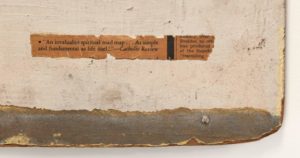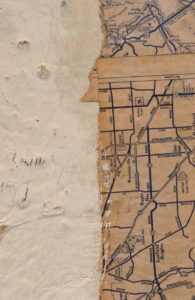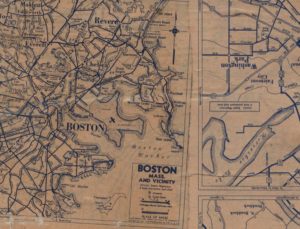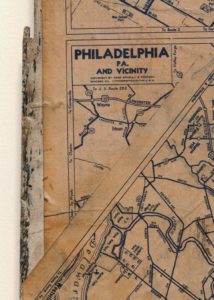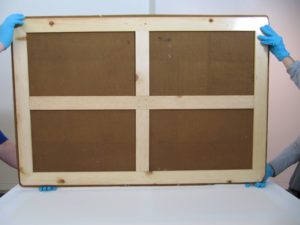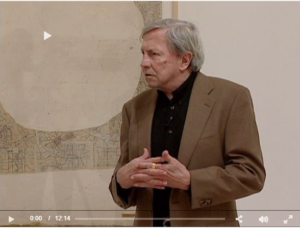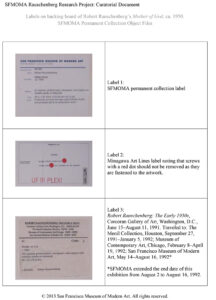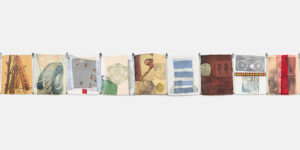Ownership History
San Francisco Museum of Modern Art, purchase through a gift of Phyllis Wattis, 1998
Exhibition History
Robert Rauschenberg, National Collection of Fine Arts, Smithsonian Institution, Washington, D.C., October 30, 1976–January 2, 1977. Traveled to: Museum of Modern Art, New York, March 25–May 17, 1977; San Francisco Museum of Modern Art, June 24–August 21, 1977; Albright-Knox Art Gallery, Buffalo, September 25–October 30, 1977; Art Institute of Chicago, December 3, 1977–January 15, 1978.
Robert Rauschenberg: The Early 1950s, Corcoran Gallery of Art, Washington, D.C., June 15–August 11, 1991. Traveled to: The Menil Collection, Houston, September 27, 1991–January 5, 1992; Museum of Contemporary Art, Chicago, February 8–April 19, 1992; San Francisco Museum of Modern Art, May 14–August 16, 1992; Guggenheim Museum SoHo, New York, October 24, 1992–January 24, 1993.
Robert Rauschenberg: A Retrospective, Solomon R. Guggenheim Museum, New York, September 19, 1997–January 7, 1998. Traveled to: The Menil Collection, Houston, February 13–May 17, 1998; Museum Ludwig, Cologne, Germany, June 27–October 11, 1998; Guggenheim Museum Bilbao, Spain, November 21, 1998–March 7, 1999.
Robert Rauschenberg, San Francisco Museum of Modern Art, May 7–September 7, 1999.
Black Mountain College: Una aventura americana, Museo Nacional Centro de Arte Reina Sofía, Madrid, October 28, 2002–January 13, 2003.
Treasures of Modern Art: The Legacy of Phyllis Wattis at SFMOMA, San Francisco Museum of Modern Art, January 30–June 24, 2003.
75 Years of Looking Forward: The Anniversary Show, San Francisco Museum of Modern Art, December 19, 2009–January 16, 2011 (on view July 1, 2010–January 16, 2011).
Leap Before You Look: Black Mountain College 1933–1957, Institute of Contemporary Art, Boston, October 10, 2015–January 24, 2016; Traveled to: Hammer Museum, University of California, Los Angeles, February 21–May 14, 2016; Did not travel to: Wexner Center for the Arts, The Ohio State University, Columbus, September 17, 2016–January 1, 2017.
In addition to appearing in the special exhibitions listed above, Quiet House—Black Mountain was shown in SFMOMA’s galleries in 1999, 2000, and 2005 as part of rotating presentations of the permanent collection.
This listing has been updated since the launch of the Rauschenberg Research Project and is complete as of August 31, 2016.
Publication History
Andrew Forge, Rauschenberg (New York: Harry N. Abrams, 1969), 171 (ill.).
Walter Hopps, ed., Robert Rauschenberg (Washington, D.C.: National Collection of Fine Arts, Smithsonian Institution, 1976), 151 (ill.).
Rauschenberg Fotografia (Florence: Archivi Alinari, 1981), n.p. (ill.).
Rauschenberg Photographe (Paris: Centre Georges Pompidou, Musée national d’art moderne, Editions Herscher, 1981), n.p. (ill.).
Robert Rauschenberg Photographs (New York: Pantheon Books, 1981), n.p. (ill.).
Mary Lynn Kotz, Rauschenberg, Art and Life (New York: Harry N. Abrams, 1990), 64 (ill.), 65.
———, “Quiet House,” Museum & Arts Washington 6, no. 6 (November/December 1990): 45 (ill.), 46 (ill.), 48 (ill.), 50 (ill.).
Walter Hopps, Robert Rauschenberg: The Early 1950s (Houston: Houston Fine Art Press, 1991), 24, 39 (ill.).
Richard Gruber, Robert Rauschenberg: Through the Lens (Kansas City: University of Missouri, 1997), 8 (ill.), 9.
Walter Hopps and Susan Davidson, eds., Robert Rauschenberg: A Retrospective (New York: Solomon R. Guggenheim Museum, 1997), 32 (ill.), 54 (ill.).
Alice Thorson, “Rauschenberg Gifted in Vernacular of Photography; Exhibit Offers Solid Look at that Aspect of Painter’s Talent,” Kansas City Star, April 4, 1997.
Joachim Jäger, Das zivilisiert Bild: Robert Rauschenberg und seine Combine-Paintings der Jahre 1960–1962 (Klagenfurt, Austria: Ritter Verlag, 1999), 73 (ill.), 74–75.
Vincent Katz, ed., Black Mountain College: Experiment in Art (Cambridge, MA: MIT Press, 2002), 157 (ill.).
Margarita Tupitsyn, Malevich and Film (New Haven, CT: Yale University Press, 2002), 100 (ill.).
Robert Saltonstall Mattison, Robert Rauschenberg: Breaking Boundaries (New Haven, CT: Yale University Press, 2003), 265n43.
Sam Hunter, Robert Rauschenberg: Works, Writings and Interviews (Barcelona: Ediciones Polígrafa, 2006), 14 (ill.).
Janet Bishop, Corey Keller, and Sarah Roberts, eds., San Francisco Museum of Modern Art: 75 Years of Looking Forward (San Francisco: San Francisco Museum of Modern Art, 2009), 432.
Carlos Javier Barcelon, “Whitney Photos Start with a Bang, End with a Bruise,” Columbia Spectator, February 4, 2009. Accessed June 23, 2013. https://www.columbiaspectator.com/2009/01/26/whitney-photos-start-bang-end-bruise.
Nicholas Cullinan, Robert Rauschenberg: Photographs 1949–1962, ed. Susan Davidson and David White (New York: Distributed Art Publishers, 2011), 14 (ill.), 15, 21, 85 (ill.).
James Boaden, “Black Painting (with Asheville Citizen),” Art History 34 (February 2011): 182.
Robert Storr, Selections from the Private Collection of Robert Rauschenberg (New York: Gagosian Gallery, 2012), 86 (ill.).
Catherine Craft, Robert Rauschenberg (London: Phaidon, 2013), 18, 19 (ill.).
Kristine Stiles, ed., Rauschenberg: Collecting & Connecting (Durham, NC: Nasher Museum of Art at Duke University, 2014), 6 (ill.).
Helen Molesworth with Ruth Erickson, eds., Leap Before You Look: Black Mountain College 1933–1957 (Boston: Institute of Contemporary Art, 2015), 138, 139 (ill.).
This listing has been updated since the launch of the Rauschenberg Research Project and is complete as of August 31, 2016.
